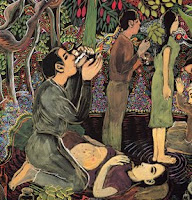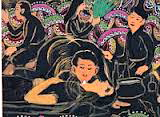In the Upper Amazon, the restricted diet — self-denial of food and sex — is a necessary precondition for creating a relationship with the plants. What the plants give in return is their willingness to help the shaman; their icaro, their song; and phlegm. Planting and nurturing the magical phlegm is an indispensable goal of the apprenticeship training; the phlegm is the physical embodiment of fuerza, the shaman’s power.
 |
| A shaman has extracted a dart from the patient’s stomach and is absorbing it into his white mariri (detail from a painting by Pablo Amaringo) |
There are a number of terms used for this shamanic phlegm. Most common is the ordinary Spanish word flema, which refers to the phlegm at its most corporeal, stored in the shaman’s chest, and manifesting the shaman’s power in physical form. It is in this phlegm that the shaman, whether healer or sorcerer, stores the virotes, the magic darts, used for both attack and defense; in the phlegm of the sorcerer are also toads, scorpions, snakes, insects — all sorts of stinging, biting, and poisonous creatures. The same substance is also called llausa and yachay. The former is the ordinary Quechua term for phlegm; the latter is the Quechua word for knowledge. The term yachay derives from the verb yacha, know, and refers specifically to ritual knowledge. The Lamista term for shaman is yachak, owner of yachay; similarly, the Napo Runa term for shaman is yachaj, one who knows.
This flema must be distinguished from mariri, which is phlegm rarefied, raised from the chest into the throat, often with the accompaniment of loud burps and belches, becoming like air, my teacher don Roberto Acho says — immaterial, vibratory, and protective. It is this mariri that extracts the magic darts, the sickness, the other evils in the patient’s body and at the same time protects the shaman from the sickness and sorcery he sucks out.
The phlegm is nourished by smoking mapacho. It is received from the maestro ayahuasquero, “like planting a seed in your chest,” don Roberto told me; nurturing one’s phlegm is like raising a plant until it is the proper size, and then maintaining it. “Flema makes you fearless,” don Roberto said. Fearlessness is a constant theme in relation to phlegm. When you have this protection, doña María Tuesta said to me, you need have no fear of anyone; the medicine grants a corazón de acero, a heart of steel. Phlegm can start to grow in the chest within months of beginning shamanic training; when smoking mapacho, the mariri may move, mysteriously, as if by itself, from chest to throat — strange burps and belches, phlegm become like air.
 |
| Shaman sucking out sickness with his white mariri (detail from a painting by Pablo Amaringo) |
The rarefication of phlegm into mariri relates it to icaros, shamanic songs. Abstraction from conceptual meaning is a key feature of such music. The most powerful icaros, such as the protective arcanas, are vocally refined into silbando, breathy and almost inaudible whistles. Thus, when learning icaros, doña María told me, I should first hum the melody, or whistle it in the breathy whispering whistle of silbando, and only then learn the words, for the words are much less important than the melody. Another shaman has told his apprentices not to be overly concerned with trying to memorize the words; singing the icaros from the heart with the correct resonance and vibration is more important.
Here there is a relationship between sound and phlegm. Both are given by the plant teachers, nurtured by mapacho and ayahuasca; both range from the grossly physical and intelligible to the rarefied, refined, air-like; converge in the act of blowing, which can both cure and kill; and unite in the magical mouth of the shaman, which contains the power and wisdom of the plant spirits.
Just as the shaman’s magical phlegm, stored in the chest, is raised and rarefied into the throat in order to protect against magical attack, becoming intangible, less physical, just like air; in the same way, the more abstract, less conceptual, less overtly intelligible the icaro, the more powerful it is. Indeed, both mariri, purified phlegm, and icaro, purified song, ultimately converge upon the same condition — that of puro sonido, pure sound, which is the the immaterial and wordless language of the plants.

- Previous Post: Mishmash
- Next Post: Indigenists and Universalists
- More Articles Related to: Ayahuasca, Shamanism



Hi,
I need to do work on myself and I am looking a reputable Shaman.
I have found many retreats on youtube but they seem rather expensive at $1900
for 12 days. Seems a little pricey to hang in the jungle, eat fish, and drink a brew made from a vine that seems to rather plentiful. And as I look more into it seems that the people that own it are white people. Seems like more exploration, the same stuff that has been going on for hundreds of years. Maybe I’m wrong, but how much do the shamans get from this, and I didn’t know the spirit world was in such need of money.
I want to start my process of being reborn thru Ayahuasca on my 40th birthday the
beginning of Feb 2013.
Thanks in advance for any and all responses
Great website by the way!
Percy Garcia at the DAS center in Peru. Real healing going on there.